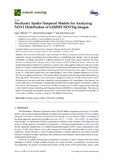Mostrar el registro sencillo del ítem
Stochastic spatio-temporal models for analysing NDVI distribution of GIMMS NDVI3g images
| dc.creator | Militino, Ana F. | es_ES |
| dc.creator | Ugarte Martínez, María Dolores | es_ES |
| dc.creator | Pérez Goya, Unai | es_ES |
| dc.date.accessioned | 2017-11-15T09:28:41Z | |
| dc.date.available | 2017-11-15T09:28:41Z | |
| dc.date.issued | 2017 | |
| dc.identifier.issn | 2072-4292 | |
| dc.identifier.uri | https://hdl.handle.net/2454/26171 | |
| dc.description.abstract | The normalized difference vegetation index (NDVI) is an important indicator for evaluating vegetation change, monitoring land surface fluxes or predicting crop models. Due to the great availability of images provided by different satellites in recent years, much attention has been devoted to testing trend changes with a time series of NDVI individual pixels. However, the spatial dependence inherent in these data is usually lost unless global scales are analyzed. In this paper, we propose incorporating both the spatial and the temporal dependence among pixels using a stochastic spatio-temporal model for estimating the NDVI distribution thoroughly. The stochastic model is a state-space model that uses meteorological data of the Climatic Research Unit (CRU TS3.10) as auxiliary information. The model will be estimated with the Expectation-Maximization (EM) algorithm. The result is a set of smoothed images providing an overall analysis of the NDVI distribution across space and time, where fluctuations generated by atmospheric disturbances, fire events, land-use/cover changes or engineering problems from image capture are treated as random fluctuations. The illustration is carried out with the third generation of NDVI images, termed NDVI3g, of the Global Inventory Modeling and Mapping Studies (GIMMS) in continental Spain. This data are taken in bymonthly periods from January 2011 to December 2013, but the model can be applied to many other variables, countries or regions with different resolutions. | en |
| dc.description.sponsorship | This research was supported by the Spanish Ministry of Economy and Competitiveness (Project MTM2014-51992-R), the Government of Navarre (Project PI015, 2016), and by the Fundación Caja Navarra-UNED Pamplona (2016). | en |
| dc.format.extent | 17 p. | |
| dc.format.mimetype | application/pdf | en |
| dc.language.iso | eng | en |
| dc.publisher | MDPI | en |
| dc.relation.ispartof | Remote sensing, 2017, 9(1), 76 | en |
| dc.rights | © 2017 by the authors; licensee MDPI, Basel, Switzerland. This article is an open access article distributed under the terms and conditions of the Creative Commons Attribution (CC-BY) license. | en |
| dc.rights.uri | https://creativecommons.org/licenses/by/4.0/ | |
| dc.subject | Kriging | en |
| dc.subject | Spatial statistics | en |
| dc.subject | Stochastic modelling | en |
| dc.title | Stochastic spatio-temporal models for analysing NDVI distribution of GIMMS NDVI3g images | en |
| dc.type | Artículo / Artikulua | es |
| dc.type | info:eu-repo/semantics/article | en |
| dc.contributor.department | Estadística e Investigación Operativa | es_ES |
| dc.contributor.department | Estatistika eta Ikerketa Operatiboa | eu |
| dc.contributor.department | Institute for Advanced Materials and Mathematics - INAMAT2 | es_ES |
| dc.rights.accessRights | Acceso abierto / Sarbide irekia | es |
| dc.rights.accessRights | info:eu-repo/semantics/openAccess | en |
| dc.identifier.doi | 10.3390/rs9010076 | |
| dc.relation.projectID | info:eu-repo/grantAgreement/MINECO//MTM2014-51992-R/ES/ | en |
| dc.relation.publisherversion | https://dx.doi.org/10.3390/rs9010076 | |
| dc.type.version | Versión publicada / Argitaratu den bertsioa | es |
| dc.type.version | info:eu-repo/semantics/publishedVersion | en |
| dc.contributor.funder | Gobierno de Navarra / Nafarroako Gobernua: Project PI015, 2016 | es |



